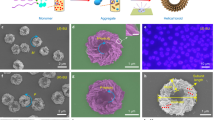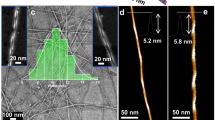Abstract
The helicates—chiral assemblies of two or more metal atoms linked by short or relatively rigid multidentate organic ligands—may be regarded as non-peptide mimetics of α-helices because they are of comparable size and have shown some relevant biological activity. Unfortunately, these beautiful helical compounds have remained difficult to use in the medicinal arena because they contain mixtures of isomers, cannot be optimized for specific purposes, are insoluble, or are too difficult to synthesize. Instead, we have now prepared thermodynamically stable single enantiomers of monometallic units connected by organic linkers. Our highly adaptable self-assembly approach enables the rapid preparation of ranges of water-stable, helicate-like compounds with high stereochemical purity. One such iron(II) ‘flexicate’ system exhibits specific interactions with DNA, promising antimicrobial activity against a Gram-positive bacterium (methicillin-resistant Staphylococcus aureus, MRSA252), but also, unusually, a Gram-negative bacterium (Escherichia coli, MC4100), as well as low toxicity towards a non-mammalian model organism (Caenorhabditis elegans).
This is a preview of subscription content, access via your institution
Access options
Subscribe to this journal
Receive 12 print issues and online access
$259.00 per year
only $21.58 per issue
Buy this article
- Purchase on Springer Link
- Instant access to full article PDF
Prices may be subject to local taxes which are calculated during checkout





Similar content being viewed by others
References
Huang, Y., Huang, J. & Chen, Y. Alpha-helical cationic antimicrobial peptides: relationships of structure and function. Protein Cell 1, 143–152 (2010).
Hancock, R. E. W. & Sahl, H.-G. Antimicrobial and host-defense peptides as new anti-infective therapeutic strategies. Nature Biotechnol. 24, 1551–1557 (2006).
Zasloff, M. Antimicrobial peptides of multicellular organisms. Nature 415, 389–395 (2002).
Tossi, A., Sandri, L. & Giangaspero, A. Amphipathic, alpha-helical antimicrobial peptides. Biopolymers 55, 4–30 (2000).
Boyle, A. L. & Woolfson, D. N. De novo designed peptides for biological applications. Chem. Soc. Rev. 40, 4295–4306 (2011).
Cummings, C. G. & Hamilton, A. D. Disrupting protein–protein interactions with non-peptidic, small molecule alpha-helix mimetics. Curr. Opin. Chem. Biol. 14, 341–346 (2010).
Haridas, V. From peptides to non-peptide alpha-helix inducers and mimetics. Eur. J. Org. Chem. 2009, 5112–5128 (2009).
Grauer, A. & König, B. Peptidomimetics—a versatile route to biologically active compounds. Eur. J. Org. Chem. 2009, 5099–5111 (2009).
Davis, J. M., Tsou, L. K. & Hamilton, A. D. Synthetic non-peptide mimetics of alpha-helices. Chem. Soc. Rev. 36, 326–334 (2007).
Lehn, J.-M. et al. Spontaneous assembly of double-stranded helicates from oligobipyridine ligands and copper(I) cations: structure of an inorganic double helix. Proc. Natl Acad. Sci. USA 84, 2565–2569 (1987).
He, C., Zhao, Y., Guo, D., Lin, Z. & Duan, C. Chirality transfer through helical motifs in coordination compounds. Eur. J. Inorg. Chem. 2007, 3451–3463 (2007).
Piguet, C., Borkovec, M., Hamacek, J. & Zeckert, K. Strict self-assembly of polymetallic helicates: the concepts behind the semantics. Coord. Chem. Rev. 249, 705–726 (2005).
Schalley, C. A., Lützen, A. & Albrecht, M. Approaching supramolecular functionality. Chem. Eur. J. 10, 1072–1080 (2004).
Hannon, M. J. & Childs, L. J. Helices and helicates: beautiful supramolecular motifs with emerging applications. Supramol. Chem. 16, 7–22 (2004).
Albrecht, M. ‘Let's Twist Again’: double-stranded, triple-stranded, and circular helicates. Chem. Rev. 101, 3457–3498 (2001).
Albrecht, M. How do they know? Influencing the relative stereochemistry of the complex units of dinuclear triple-stranded helicate-type complexes. Chem. Eur. J. 6, 3485–3489 (2000).
Caulder, D. L. & Raymond, K. N. Supermolecules by design. Acc. Chem. Res. 32, 975–982 (1999).
Constable, E. C. Oligopyridines as helicating ligands. Tetrahedron 48, 10013–10059 (1992).
Glasson, C. R. K. et al. Microwave synthesis of a rare [Ru2L3]4+ triple helicate and its interaction with DNA. Chem. Eur. J. 14, 10535–10538 (2008).
Yu, H., Wang, X., Fu, M., Ren, J. & Qu, X. Chiral metallo-supramolecular complexes selectively recognize human telomeric G-quadruplex DNA. Nucleic Acids Res. 36, 5695–5703 (2008).
Schoentjes, B. & Lehn, J.-M. Interaction of double-helical polynuclear copper(I) complexes with double-stranded DNA. Helv. Chim. Acta 78, 1–12 (1995).
Cardo, L., Sadovnikova, V., Phongtongpasuk, S., Hodges, N. J. & Hannon, M. J. Arginine conjugates of metallo-supramolecular cylinders prescribe helicity and enhance DNA junction binding and cellular activity. Chem. Commun. 47, 6575–6577 (2011).
Boer, D. R. et al. Self-assembly of functionalizable two-component 3D DNA arrays through the induced formation of DNA three-way-junction branch points by supramolecular cylinders. Angew. Chem. Int. Ed. 49, 2336–2339 (2010).
Richards, A. D., Rodger, A., Hannon, M. J. & Bolhuis, A. Antimicrobial activity of an iron triple helicate. Int. J. Antimicrob. Agents 33, 469–472 (2009).
Parajo, Y. et al. Effect of bridging ligand structure on the thermal stability and DNA binding properties of iron(II) triple helicates. Dalton Trans. 4868–4874 (2009).
Malina, J., Hannon, M. J. & Brabec, V. DNA binding of dinuclear iron(II) metallosupramolecular cylinders. DNA unwinding and sequence preference. Nucleic Acids Res. 36, 3630–3638 (2008).
Malina, J., Hannon, M. J. & Brabec, V. Interaction of dinuclear ruthenium(II) supramolecular cylinders with DNA: sequence-specific binding, unwinding, and photocleavage. Chem. Eur. J. 14, 10408–10414 (2008).
Hotze, A. C. G. et al. Supramolecular iron cylinder with unprecedented DNA binding is a potent cytostatic and apoptotic agent without exhibiting genotoxicity. Chem. Biol. 15, 1258–1267 (2008).
Pascu, G. I., Hotze, A. C. G., Sanchez-Cano, C., Kariuki, B. M. & Hannon, M. J. Dinuclear ruthenium(II) triple-stranded helicates: luminescent supramolecular cylinders that bind and coil DNA and exhibit activity against cancer cell lines. Angew. Chem. Int. Ed. 46, 4374–4378 (2007).
Malina, J., Hannon, M. J. & Brabec, V. Recognition of DNA three-way junctions by metallosupramolecular cylinders: gel electrophoresis studies. Chem. Eur. J. 13, 3871–3877 (2007).
Oleksi, A. et al. Molecular recognition of a three-way DNA junction by a metallosupramolecular helicate. Angew. Chem. Int. Ed. 45, 1227–1231 (2006).
Hotze, A. C. G., Kariuki, B. M. & Hannon, M. J. Dinuclear double-stranded metallosupramolecular ruthenium complexes: potential anticancer drugs. Angew. Chem. Int. Ed. 45, 4839–4842 (2006).
Meistermann, I. et al. Intramolecular DNA coiling mediated by metallosupramolecular cylinders: differential binding of P and M helical enantiomers. Proc. Natl Acad. Sci. USA 99, 5069–5074 (2002).
Hannon, M. J. et al. Intramolecular DNA coiling mediated by a metallo-supramolecular cylinder. Angew. Chem. Int. Ed. 40, 879–884 (2001).
Howson, S. E. & Scott, P. Approaches to the synthesis of optically pure helicates. Dalton Trans. 40, 10268–10277 (2011).
Howson, S. E. et al. Self-assembling optically pure Fe(A-B)3 chelates. Chem. Commun. 1727–1729 (2009).
Howson, S. E. et al. Origins of stereoselectivity in optically pure phenylethaniminopyridine tris-chelates M(NN′)3n+ (M=Mn, Fe, Co, Ni and Zn). Dalton Trans. 40, 10416–10433 (2011).
Telfer, S. G., Kuroda, R. & Sato, T. Stereoselective formation of dinuclear complexes with anomalous CD spectra. Chem. Commun. 1064–1065 (2003).
Telfer, S. G., Sato, T., Kuroda, R., Lefebvre, J. & Leznoff, D. B. Dinuclear complexes of chiral tetradentate pyridylimine ligands: diastereoselectivity, positive cooperativity, anion selectivity, ligand self-sorting based on chirality, and magnetism. Inorg. Chem. 43, 421–429 (2004).
Hohenstein, E. G. & Sherrill, C. D. Effects of heteroatoms on aromatic π–π interactions: benzene–pyridine and pyridine dimer. J. Phys. Chem. A 113, 878–886 (2009).
Xu, J., Parac, T. N. & Raymond, K. N. meso myths: what drives assembly of helical versus meso-[M2L3] clusters? Angew. Chem. Int. Ed. 38, 2878–2882 (1999).
Bakunova, S. M. et al. Synthesis and antiprotozoal activity of pyridyl analogues of pentamidine. J. Med. Chem. 52, 4657–4667 (2009).
Hidaka, J. & Douglas, B. E. Circular dichroism of coordination compounds. II. Some metal complexes of 2,2′-dipyridyl and 1,10-phenanthroline. Inorg. Chem. 3, 1180–1184 (1964).
Ziegler, M. & von Zelewsky, A. Charge-transfer excited state properties of chiral transition metal coordination compounds studied by chiroptical spectroscopy. Coord. Chem. Rev. 177, 257–300 (1998).
Holden, M. T. G. et al. Complete genomes of two clinical Staphylococcus aureus strains: evidence for the rapid evolution of virulence and drug resistance. Proc. Natl Acad. Sci. USA 101, 9786–9791 (2004).
Dwyer, F. P., Gyarfas, E. C., Rogers, W. P. & Koch, J. H. Biological activity of complex ions. Nature 170, 190–191 (1952).
Bolhuis, A. et al. Antimicrobial activity of ruthenium-based intercalators. Eur. J. Pharm. Sci. 42, 313–317 (2011).
Hancock, R. E. W. The bacterial outer membrane as a drug barrier. Trends Microbiol. 5, 37–42 (1997).
Artal-Sanz, M., de Jong, L. & Tavernarakis, N. Caenorhabditis elegans: a versatile platform for drug discovery. Biotechnol. J. 1, 1405–1418 (2006).
Leung, M. C. K. et al. Caenorhabditis elegans: an emerging model in biomedical and environmental toxicology. Toxicol. Sci. 106, 5–28 (2008).
Acknowledgements
The authors acknowledge the EPSRC and the University of Warwick for financial support. The authors thank the EPSRC National Crystallography Service (University of Southampton, UK) for data collection.
Author information
Authors and Affiliations
Contributions
S.E.H. synthesized the compounds, carried out the spectroscopic studies, analysed data and drafted the paper. A.B. designed and performed the antimicrobial and toxicity studies. V.B. and J.M. designed and performed the ethidium bromide displacement experiments and DNA melting studies. G.J.C. solved and refined the X-ray crystal data. A.R. designed the linear dichroism studies and assisted with analysis of the resulting data. P.S. conceived and directed the project, analysed data and wrote the paper.
Corresponding author
Ethics declarations
Competing interests
The authors declare no competing financial interests.
Supplementary information
Supplementary information
Supplementary information (PDF 1013 kb)
Supplementary information
Crystallographic data for compound delta4a. (CIF 36 kb)
Rights and permissions
About this article
Cite this article
Howson, S., Bolhuis, A., Brabec, V. et al. Optically pure, water-stable metallo-helical ‘flexicate’ assemblies with antibiotic activity. Nature Chem 4, 31–36 (2012). https://doi.org/10.1038/nchem.1206
Received:
Accepted:
Published:
Issue Date:
DOI: https://doi.org/10.1038/nchem.1206
This article is cited by
-
Self-assembly and peripheral guest-binding of two triangular Zn(II) helicates
Chemical Papers (2024)
-
Direct observation of long-range chirality transfer in a self-assembled supramolecular monolayer at interface in situ
Nature Communications (2022)
-
Stabilization of human telomeric RNA G-quadruplex by the water-compatible optically pure and biologically-active metallohelices
Scientific Reports (2020)
-
Water-mediated deracemization of a bisporphyrin helicate assisted by diastereoselective encapsulation of chiral guests
Nature Communications (2019)
-
Supramolecular Kandinsky circles with high antibacterial activity
Nature Communications (2018)



